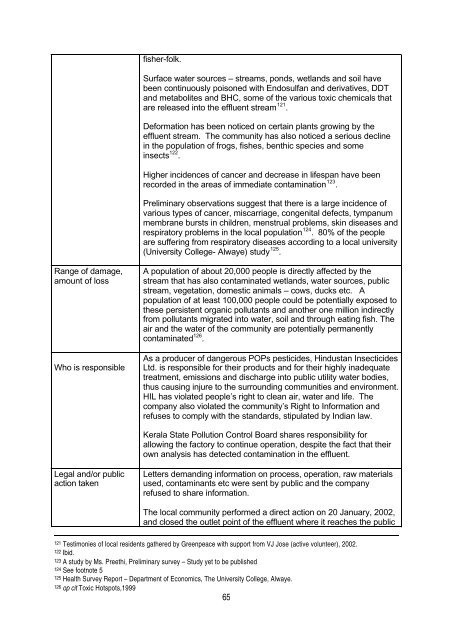Umweltverbrechen multinationaler Konzerne - Greenpeace
Umweltverbrechen multinationaler Konzerne - Greenpeace
Umweltverbrechen multinationaler Konzerne - Greenpeace
Sie wollen auch ein ePaper? Erhöhen Sie die Reichweite Ihrer Titel.
YUMPU macht aus Druck-PDFs automatisch weboptimierte ePaper, die Google liebt.
Range of damage,<br />
amount of loss<br />
Who is responsible<br />
Legal and/or public<br />
action taken<br />
fisher-folk.<br />
Surface water sources – streams, ponds, wetlands and soil have<br />
been continuously poisoned with Endosulfan and derivatives, DDT<br />
and metabolites and BHC, some of the various toxic chemicals that<br />
are released into the effluent stream 121 .<br />
Deformation has been noticed on certain plants growing by the<br />
effluent stream. The community has also noticed a serious decline<br />
in the population of frogs, fishes, benthic species and some<br />
insects 122 .<br />
Higher incidences of cancer and decrease in lifespan have been<br />
recorded in the areas of immediate contamination 123 .<br />
Preliminary observations suggest that there is a large incidence of<br />
various types of cancer, miscarriage, congenital defects, tympanum<br />
membrane bursts in children, menstrual problems, skin diseases and<br />
respiratory problems in the local population 124 . 80% of the people<br />
are suffering from respiratory diseases according to a local university<br />
(University College- Alwaye) study 125 .<br />
A population of about 20,000 people is directly affected by the<br />
stream that has also contaminated wetlands, water sources, public<br />
stream, vegetation, domestic animals – cows, ducks etc. A<br />
population of at least 100,000 people could be potentially exposed to<br />
these persistent organic pollutants and another one million indirectly<br />
from pollutants migrated into water, soil and through eating fish. The<br />
air and the water of the community are potentially permanently<br />
contaminated 126 .<br />
As a producer of dangerous POPs pesticides, Hindustan Insecticides<br />
Ltd. is responsible for their products and for their highly inadequate<br />
treatment, emissions and discharge into public utility water bodies,<br />
thus causing injure to the surrounding communities and environment.<br />
HIL has violated people’s right to clean air, water and life. The<br />
company also violated the community’s Right to Information and<br />
refuses to comply with the standards, stipulated by Indian law.<br />
Kerala State Pollution Control Board shares responsibility for<br />
allowing the factory to continue operation, despite the fact that their<br />
own analysis has detected contamination in the effluent.<br />
Letters demanding information on process, operation, raw materials<br />
used, contaminants etc were sent by public and the company<br />
refused to share information.<br />
The local community performed a direct action on 20 January, 2002,<br />
and closed the outlet point of the effluent where it reaches the public<br />
121 Testimonies of local residents gathered by <strong>Greenpeace</strong> with support from VJ Jose (active volunteer), 2002.<br />
122 Ibid.<br />
123 A study by Ms. Preethi, Preliminary survey – Study yet to be published<br />
124 See footnote 5<br />
125 Health Survey Report – Department of Economics, The University College, Alwaye.<br />
126 op cit Toxic Hotspots,1999<br />
65

















